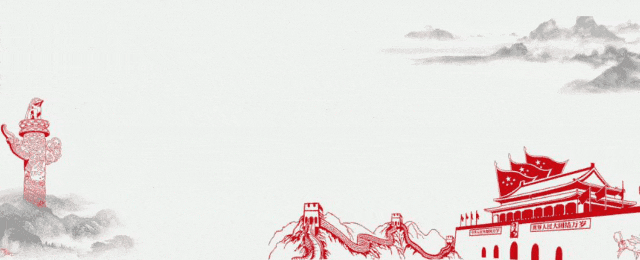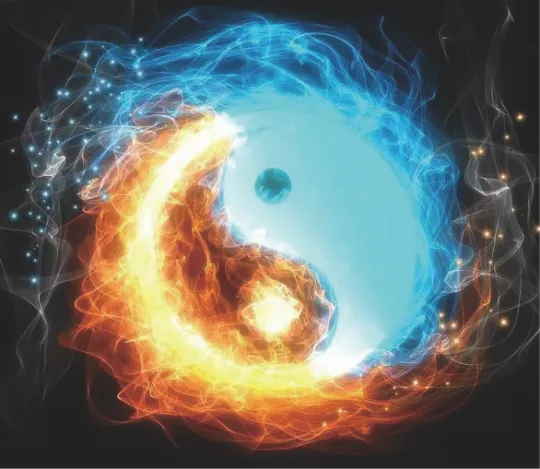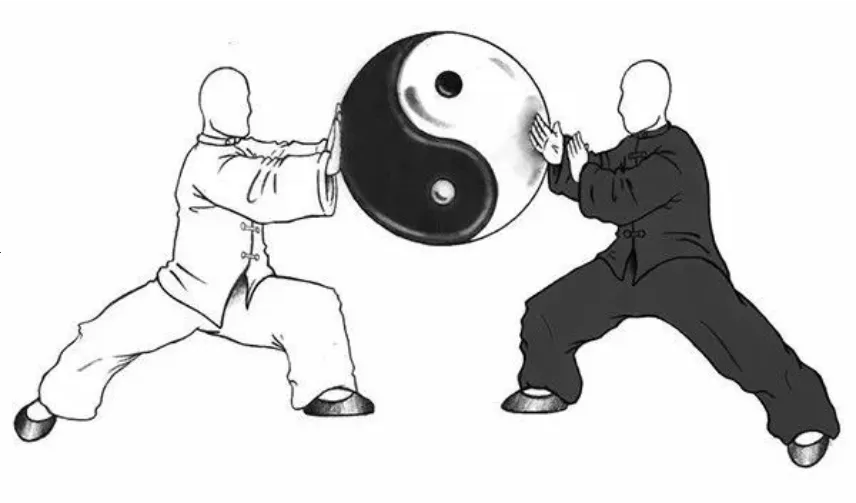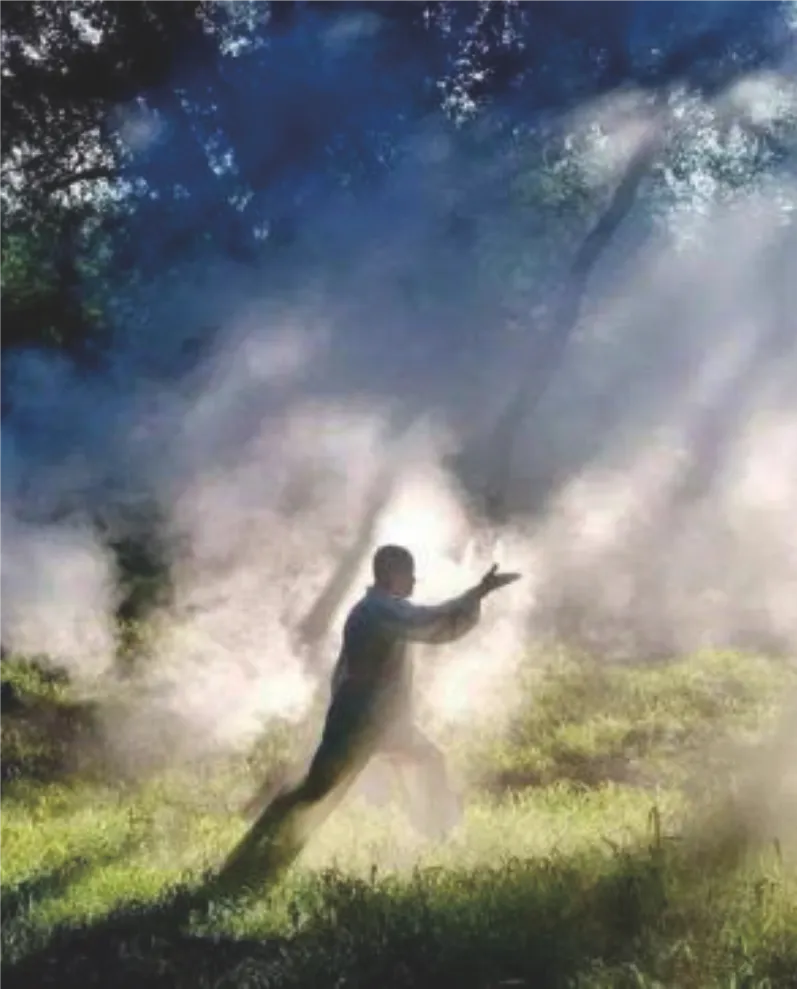

As we enter a new era, the terms “Tai Chi” and “Tai Chi Quan” are increasingly used, both domestically and internationally, playing an indispensable role in promoting national fitness, fostering international exchanges, and enhancing Chinese culture, becoming one of the most beautiful cultural symbols of the Chinese nation.
In exploring the reasons behind this phenomenon, one cannot help but ask, what is Tai Chi? What is Tai Chi Quan? Following the trajectory of Chinese civilization, how should we standardize, systematize, and even industrialize this cultural heritage? Having been fascinated by Tai Chi Quan for over twenty years, I have gained some insights and would like to share them with everyone, inviting corrections from experts.
What is Tai Chi Quan
The term Tai Chi originates from the “I Ching (Yijing) – Appended Remarks”: “The I Ching has Tai Chi, which generates the two opposites (Yin and Yang), the two opposites generate the four images, and the four images generate the eight trigrams.” Tai Chi refers to the source from which all things arise. In the Northern Song Dynasty, Zhou Dunyi inherited this thought and wrote the “Diagram of Tai Chi.” Zhu Xi of the Southern Song Dynasty believed that “the principles of all things in heaven and earth are Tai Chi.” Sun Yat-sen used “Tai Chi” to translate the Western term “ether,” considering Tai Chi (ether) to be the root of the material world. Tai Chi is both infinitely small and infinitely large, profound and extensive.
Tai Chi is the totality of the contradictions of opposing unity that compose things, a synthesis of classical Chinese philosophy, standing on the foundation of Yin and Yang, which is the cornerstone of this philosophy. Tai Chi Quan draws from the cosmological ontology of the Tai Chi doctrine, which states that “Wu Ji (the ultimate void) generates Tai Chi.” In its primordial state, it is unified and formless; later, Yin and Yang change, movement and stillness blend, emptiness and fullness give rise to each other, internal and external cultivation coexist, advancing and retreating freely, opening and closing in order, with a mind as calm as water yet moving without wind. The simple language of the body presents myriad phenomena, and every move and posture highlights the fundamental characteristic—roundness.

The theory of Tai Chi Quan is profound and extensive.
The core value of Tai Chi Quan can be simply summarized as a martial spirit rooted in combat, self-healing effects for fitness, and moral cultivation as its soul. It integrates various functions of culture, philosophy, and health preservation, standing out in the historical winds while blending seamlessly with the times, nurturing qualities and nourishing the spirit in silence through cultivation, harmony, governance, and peace. Therefore, the practice of Tai Chi Quan can be summarized as: cultivating essence, energy, spirit, and refining character and thought, pursuing the realm of rhythm and Dao. Throughout history, practitioners have been no exception. Regardless of the level attained, each is a beautiful landscape. The deeper one enters, the more one can feel the exquisite beauty and boundless mysteries.
The core essence of practicing Tai Chi Quan is to relax, enter tranquility, and use intention, which requires a long-term process. The ancient saying that one should not leave home for ten years in Tai Chi practice is indeed reasonable. Relaxed yet not collapsed, pure yet not muddled, focused yet not rigid. This requires long-term practice and understanding, and practicing relaxation, stillness, and intention is to practice the extreme, which is the process of approaching the truth. Practicing Tai Chi Quan is practicing the extreme; the great way is simple.
Tai Chi Quan is Tai Chi + Quan (fist). Tai Chi refers to the description of the evolution of the cosmic great way by the ancestors of China. From non-being to being, Wu Ji generates Tai Chi; one gives birth to two, Tai Chi has Yin and Yang; two gives birth to three, heaven, earth, and humanity are the three talents; three gives birth to all things. One Yin and one Yang is called Dao, and Tai Chi is the great way of the universe’s endless generation.
Tai Chi Quan encompasses philosophy, science, medicine, and martial arts.
Philosophy involves the balance of Yin and Yang, the independence of Yin and Yang, the opposition of Yin and Yang, the presence of Yang within Yin and vice versa, and the mutual rooting and transformation of Yin and Yang. The philosophical principles of Tai Chi Quan completely align with materialist dialectics, inheriting a continuous lineage.
Science, the foundation of Tai Chi is Yin and Yang. The development of binary theory and technology has evolved into networks, becoming the technical support of modern society, with Yin and Yang being analogous and originating from the same source. The philosophy of Tai Chi, where Yin does not leave Yang and Yang does not leave Yin, aligns with the principles of modern physics, such as quantum entanglement and quantum mechanics.
Medicine, Traditional Chinese Medicine (TCM) is profound and emphasizes regulation. What does it regulate? It regulates the balance of Yin and Yang. Tai Chi Quan emphasizes the balance of Yin and Yang. Long-term correct practice of Tai Chi Quan can prevent diseases, adjust sub-health conditions, and treat existing illnesses. This is the fundamental reason why Tai Chi Quan has become popular worldwide.
Martial arts, all martial arts in the world are based on strength, while only internal martial arts, particularly Tai Chi Quan, are based on wisdom as the soul. Tai Chi Quan emphasizes using the small to overcome the large and the weak to defeat the strong.
The art of Tai Chi Quan is the cornerstone of Tai Chi studies. The brilliance of Tai Chi Quan can be described from five aspects: national studies and national arts, medical arts, arts, academic studies, and strategic tactics.
Tai Chi Quan is referred to as “national studies and national arts,” meaning that Tai Chi Quan, like national studies (Confucianism, Daoism, Sinicized Buddhism), national medicine (Traditional Chinese Medicine, Chinese herbal medicine, acupuncture), national drama (Chinese opera represented by Peking opera), national music, national calligraphy, and national painting, is a cultural treasure unique to China.
Tai Chi Quan is referred to as “medical arts,” meaning that practicing Tai Chi Quan can strengthen the body and improve immunity, while also cultivating the mind and relieving psychological stress, healing psychological ailments, thus “preventing diseases”; adhering to the basic principles of relaxation and tranquility, unblocking meridians, and ensuring smooth blood flow to avoid pain, effectively regulating sub-health conditions, thus “removing sub-health”; practicing basic routines along with targeted practice can lead to “treating existing illnesses.”
Tai Chi Quan is referred to as “arts,” primarily as the art of combat. It originates from combat but transcends it, with concepts that are more about wisdom and science. A highly skilled Tai Chi Quan master can act freely, follow the situation, and use the technique of “four ounces deflecting a thousand pounds” to defeat an opponent, demonstrating the wisdom of a sage; when the opponent does not move, I do not move; when the opponent desires to move, I have already moved; every action of the opponent is under my control, achieving the state of “others do not know me, I alone know others”—a state of enlightenment, embodying the wisdom of the divine; being humble and magnanimous, yielding to others, never taking the initiative to attack, embodying the demeanor of a saint. Secondly, it is the art of performance, where practitioners of Tai Chi Quan are calm and relaxed, in a pleasant mood, with gentle pulse, even and fine breathing, and profound meaning; their bodies are relaxed, movements are graceful, internal and external are in harmony, emptiness and fullness alternate, movement and stillness interweave, hardness and softness complement each other, and Yin and Yang harmonize, providing practitioners with an aesthetic enjoyment.
Tai Chi Quan is referred to as “academic studies,” meaning that Tai Chi Quan has a systematic technical and theoretical framework. The technical system mainly consists of the eight gates, five steps, and thirteen postures. Peng, Lu, Ji, An correspond to the four directions (North, South, East, West); Cai, Nian, Zhou, Kao correspond to the four corners (Northwest, Southwest, Northeast, Southeast). The four directions and four corners combine to form the eight gates; Jin, Tui, Gu, Pan correspond to the five elements (Metal, Wood, Water, Fire, Earth), forming the five steps; the eight gates and five steps combine to form the thirteen postures. The Tai Chi community universally regards the theoretical system of Wang Zongyue’s “Treatise on Tai Chi Quan” from the Ming Dynasty as the standard, with every move, intention, and thought adhering to the ten principles (Yin and Yang, emptiness and fullness, internal and external, hardness and softness, movement and stillness). Each major school, while adhering to the basic principles of Tai Chi Quan, has developed its unique characteristics based on the insights of its masters, possessing unified theoretical traits and distinctive technical features.
Tai Chi Quan is referred to as “strategic tactics,” meaning that Tai Chi Quan embodies strategic thinking, awareness, vision, and tactical concepts, rules, skills, and behaviors. Tai Chi Quan requires the use of whole-body strength, with internal and external in harmony, employing holistic thinking; to go left, first go right; to go right, first go left; to go up, first go down; to go down, first go up, demonstrating reverse thinking; when one moves, all move; when one is still, all are still, reflecting systemic thinking. During the first land revolution period, our party primarily used armed encirclement, with the initial spark wanting to ignite a prairie fire, and the primary issue was survival. The Red Army established the 16-character guerrilla warfare strategy: when the enemy advances, we retreat; when the enemy is stationed, we disrupt; when the enemy is tired, we strike; when the enemy retreats, we pursue. This aligns perfectly with the Tai Chi Quan principle of yielding to others, following the flow, and being soft when the opponent is hard. Following this principle, our party grew from small to large, from few to many, from weak to strong, driving the Japanese invaders out of the country and forcing the Kuomintang reactionaries to Taiwan, compelling American imperialism to sign a ceasefire agreement at the negotiation table without victory for the first time.
Tai Chi Quan is the great way of the universe’s endless generation, encompassing four studies: philosophy, science, medicine, and martial arts, and five arts: national studies and national arts, medical arts, arts, academic studies, and strategic tactics. This is my basic interpretation of the conceptual essence of Tai Chi Quan.
Where Does Tai Chi Quan Come From
No civilization arises out of thin air. Where does Tai Chi Quan come from? In terms of dynasties, there are theories from the Tang, Song, Ming, and Qing dynasties; in terms of figures, there are theories from Wang Zongyue, Zhang Sanfeng, Chen Wangting, and Yang Luchan. Tai Chi Quan is rooted in the land of China, with a long history, like a river that absorbs many tributaries, ultimately forming a grand whole. Tracing the historical context, there is the saying of the five ancestors: the ancestors of I Ching, virtue, medicine, military, and technique.
The “ancestor of I Ching” includes the three sages: Fuxi, King Wen of Zhou, and Confucius. Fuxi created the eight trigrams, King Wen developed the I Ching and calculated the sixty-four hexagrams, and Confucius authored the “Commentary on the I Ching.” Tai Chi Quan draws from the core ideas of the I Ching, the “three changes” (changeable, simple, unchangeable), and the ten principles (Yin and Yang, emptiness and fullness, movement and stillness, hardness and softness, internal and external) are based on the Yin and Yang of the I Ching, thus Tai Chi Quan respects the great achievers of the I Ching system as the “ancestor of I Ching.”
The “ancestor of virtue” is none other than Laozi and Zhuangzi. Laozi, Li Er, authored the “Dao De Jing” and founded the Daoist school. Zhuangzi inherited and promoted Laozi’s core idea of “following the Dao of nature.” Tai Chi Quan draws from the core ideas of the “Dao De Jing” of “guarding softness” and “following the Dao of nature,” forming the technical thinking of relaxed, still, and intentional Tai Chi Quan, gradually achieving the “wonderful realm” of using softness to overcome hardness, achieving the miraculous through non-action. Therefore, Tai Chi Quan should respect the founders of Daoism, Laozi and Zhuangzi, as the “ancestor of virtue.”
The “ancestor of medicine” is revered as Qibo. Qibo authored the “Huangdi Neijing” in dialogue with the Yellow Emperor. The “Huangdi Neijing” is the ancestor of TCM theory, with its core idea being the unity of heaven and humanity, emphasizing that health preservation should follow nature and not violate the seasons, adapting to the changes of spring, summer, autumn, and winter. Tai Chi Quan fully draws from the core idea of the unity of heaven and humanity in the “Huangdi Neijing,” following the laws of heaven and earth, taking the path of Yin and Yang, following the manifestations of nature, and maintaining moderation. Therefore, Tai Chi Quan respects Qibo as the “ancestor of medicine.”
The “ancestor of military” is revered as Sun Wu. The “Art of War” by Sunzi is the earliest existing military book in China and the earliest military work in the world, praised by the global military community as the “sacred classic of military science,” with its author Sun Wu being revered as the “God of War.” Tai Chi Quan draws from the core ideas of the “Art of War” of “cautious warfare”—”the commander who knows the army is the master of the people’s lives and the nation’s safety” and “knowing oneself and knowing the enemy leads to victory in every battle,” establishing the idea of cautious warfare and the realm of understanding the opponent without revealing oneself. The Tai Chi Quan master Yang Luchan is known as “Yang Invincible,” vividly illustrating the practical value of Tai Chi Quan. Therefore, Tai Chi Quan respects Sun Wu as the “ancestor of military.”
The “ancestor of technique” is Zhang Sanfeng. Observing the fight between a magpie and a snake, Zhang Sanfeng realized the principle of waiting for the labor to tire and using stillness to control movement, thus creating “Wudang Soft Fist” and naming it “Tai Chi.” Therefore, Tai Chi Quan respects Zhang Sanfeng as the “ancestor of technique.”
In summary, the conclusion is clear: Tai Chi, Tai Chi Quan, and Tai Chi culture are treasures of Chinese culture, growing alongside Chinese civilization, relying on the five ancestors, flowing through the ages, and enduring without decline.

Tai Chi Quan is a treasure of Chinese culture.
Since the founding of the new China, especially since the reform and opening up, the economic and social landscape has undergone tremendous changes. With the popularization of the national fitness movement, Tai Chi Quan has gained more opportunities and development, and its influence is growing. Many parks, public squares, and fitness venues in cities are filled with Tai Chi Quan enthusiasts. Renowned masters not only accept disciples but also receive invitations to guide the public in factories and communities. In 2006, Tai Chi Quan was included in the first batch of national intangible cultural heritage lists. During the opening ceremony of the 2008 Olympic Games, Tai Chi Quan shone brightly on the world stage. China’s “National Fitness Plan (2011-2015)” also specifically proposed vigorously promoting Tai Chi Quan (and sword), with various exchange activities becoming increasingly frequent. Health, education, and sports departments have all listed Tai Chi Quan as an important project to promote, and all sectors of society are paying more attention to the development of Tai Chi Quan.
At the same time, the global spread of Tai Chi Quan is gradually expanding, with the number of international “fans” of Tai Chi Quan increasing daily, forming a trend centered in China, extending to Japan, South Korea, Southeast Asia, Australia, France, the United States, Sweden, the United Kingdom, Mexico, Finland, and expanding to South America, the Middle East, Africa, Central America, and Central Asia.
Despite the significant achievements in the development of Tai Chi Quan, like many traditional projects passed down through the ages, it also faces some urgent problems and challenges that need to be addressed, such as gaps in inheritance, shortcomings in professionalism and standardization, and the need for updates and diversification in inheritance methods.
Where is Tai Chi Quan Going
What is the future direction of Tai Chi Quan? Looking at the development history of Tai Chi Quan, it has followed a trajectory of family business, profession, specialization, and industry, from which we can infer the future direction and path of Tai Chi Quan.
In the long primitive society and slave society, Tai Chi Quan was still in its infancy, rough and scattered, like wild grass sprouting freely, far from emerging from a chaotic state. Entering the feudal society, humanity welcomed the era of cold weapons. Tai Chi Quan, with its superb combat functions, was highly esteemed, thus becoming stagnant, passed down as a family secret, revered as a “family business.”
In modern times, the market for the combat function of Tai Chi Quan has diminished. Out of survival needs, Tai Chi Quan masters stepped out of their homes and into society to make a living. Represented by Yang Luchan, they entered Beijing and royal courts, opening a new phase of establishing schools and teaching Tai Chi Quan, making the transmission of Tai Chi Quan a “profession” for masters.
In contemporary society, Tai Chi Quan has shifted from a focus on combat functions to a focus on fitness functions. With the implementation of the Healthy China strategy, traditional methods of establishing schools and teaching can no longer meet the people’s beautiful needs for health and fitness. Tai Chi Quan and many other national studies and arts urgently need innovative inheritance methods.
First, establish and develop a theoretical discipline system for Tai Chi Quan, introducing professional Tai Chi cultural research institutions or organizations, gathering and cultivating specialized talents, clarifying the connections between Tai Chi Quan and various disciplines such as philosophy, medicine, I Ching, aesthetics, military strategy, and psychology through practice and research, and thoroughly explaining this ancient cultural project using scientific methods and modern language, allowing more young people to understand, recognize, and love it. In 2010, Handan University introduced Tai Chi Quan culture into higher education, establishing a dedicated major for scientific inheritance, which is undoubtedly a milestone event in the history of Tai Chi Quan development in China. In 2018, due to the vigorous development of the Tai Chi Quan culture major at the university, Handan University was approved by the Ministry of Education as a “National Base for the Dissemination of Excellent Traditional Chinese Culture (Tai Chi),” a unique honor for Tai Chi, ranking 11th among the first batch of 55 universities, joining Peking University and Tsinghua University in the national first echelon of inheriting excellent traditional Chinese culture. In 2020, at the invitation of the South Sea Fleet of the People’s Liberation Army, the “Sailor Tai Chi” was created; in 2023, nearly 200 teachers and students from Handan Tai Chi Culture College went to the South Sea Fleet for comprehensive training and promotion.
Secondly, strengthening the brand building of Tai Chi Quan requires more professional operations and a more modern and international perspective, further creating and expanding brand influence, deeply exploring brand potential. Professional competitions, international exchanges, martial arts schools, film and television works, and online dissemination should all work together to create a new wave of Tai Chi Quan globally, shaping an influential Tai Chi Quan cultural brand in the new era.
Today, the realization of industrialization of cultural forms is essential for sustainable development, and Tai Chi Quan is no exception. Tai Chi Quan already has a large consumer base and a broad market globally, with vast development prospects. Promoting the physical, professional, and industrial development of Tai Chi Quan is imperative. In the future, the inheritance of Tai Chi Quan will form a huge emerging industry, with “Tai Chi +” and “+ Tai Chi” becoming the mainstream business models of the Tai Chi industry. As a necessary link in the Tai Chi industry chain, “talent + product + capital + market + N” will play an increasingly significant role in the entire industrial development system.
It is urgent to integrate resources from the government, universities, and enterprises, strengthen government guidance and policy support; universities should cultivate and scientifically inherit; enterprises should intervene and provide capital support, to develop more distinctive Tai Chi Quan cultural products, better meet people’s demand for quality Tai Chi Quan products, and provide strong momentum for promoting Tai Chi Quan culture.
Following this line of thought, the next steps we need to take are limitless. Strategically speaking, in brief, it is to establish scientific inheritance, create Tai Chi studies; promote international dissemination, benefit humanity; advance social promotion, benefit the public; and develop industry sustainably. Tactically, we strive to achieve the three grand goals of “creating Tai Chi studies, establishing a Chinese Tai Chi University, and promoting Tai Chi Quan into the Olympics,” accomplishing the great cause of Tai Chi.
Tai Chi is a treasure originating from China, integrating into the world, and benefiting humanity.

The future development of the Tai Chi industry is limitless.
 Source: “Zhaodu Culture” magazineEditor: Zhang Yu Ji XiangReviewer: Meng QingwenSubmission Email: [email protected]Contact Number: 0310—3112926
Source: “Zhaodu Culture” magazineEditor: Zhang Yu Ji XiangReviewer: Meng QingwenSubmission Email: [email protected]Contact Number: 0310—3112926



Scan to follow us
Previous reviews
◆ The 15th meeting of the 13th Standing Committee of the Municipal Political Consultative Conference was held◆ The Municipal Political Consultative Conference held a mobilization and deployment meeting for the construction of the work station for political consultative committee members◆ The Municipal Political Consultative Conference held the 13th session of the Political Consultative Conference Classroom and the 8th Weekend Lecture Hall

Share

Like

View

